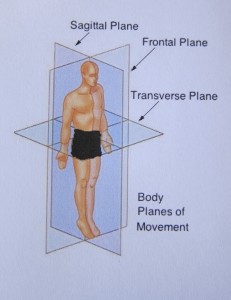Understanding the planes of movement of the human body is beneficial as it allows us to choose exercises that will help us with functional movements both for everyday life and in our chosen sport. Some critics say that with our exercise programs we tend to be more in the sagittal and frontal planes, neglecting the transverse.
Let’s take a look at these three planes of movement, what they are, and some exercises that you can do to cover them all.
The Sagittal Plane: This is a vertical plane which divides the body into left and right sides as you can see in the diagram below. The two basic movements in this plane are flexion and extension.
Some exercise examples that work in this plane are:
Squats: which can be performed either as bodyweight, barbell both front and back, dumbbells by sides or held in the front position
Chin-ups: which can be performed on an assisted chin-up machine or bodyweight and weighted without assistance
Bench Press: (Close grip) performed the same as a normal bench press but with a close grip which means that your elbows are bent and the movement is vertical rather than horizontal.
The Frontal Plane: This is also a vertical plane, however it goes from side to side that divides the body into anterior and posterior parts, again refer to the diagram. The primary movements in the frontal plane are abduction (movement away from the body midline) and adduction (movement toward body midline)
Some exercise examples that work in this plane are:
Shoulder Press: which can be performed with a machine, barbell and dumbbells, although with dumbbells held palms facing each other and elbows pointing to the front it becomes a sagittal plane movement.
Wide Lateral Pulldown: performed on a machine either cable or resistance
Lateral Raises: performed either bodyweight or with dumbbells, kettle bells or any weighted objects
Pull Ups: wide grip performed on assisted pull-up machine or bodyweight and weighted on pull-up frame.
The Transverse Plane: This is a horizontal plane that divides the body into upper and lower parts, or superior and inferior in anatomical terminology. Most movement that occurs in this plane involves rotation. Movement that takes part of the body outward is called lateral or external rotation, and movement that takes part of the body inward is called medial or internal rotation.
Some exercise examples that work in this plane are:
Russian Twist: Sit down on the floor with your feet flat knees bent holding a medicine ball in both hands at chest level. Twist (rotate) your torso to one side lowering the ball toward the ground near your hip joint then twist your torso back to the other side. Keep your feet flat on the ground throughout the movement. You can progress by lifting you feet of the ground and keeping them still while executing the movement.
Wood Chop: Set a cable machine handle at about head height. Hold the handle with both hands and keeping your feet planted, hips pointed forward and your arms straight, rotate your upper body from above your right shoulder to below your right hip. Repeat on each side of your body.
Medicine Ball Side Wall Throws: Hold a medicine ball in your hands and stand side on to a solid wall. Keep your feet planted parallel with the wall and your arms between shoulders and mid torso height, rotate and throw the ball against the wall.
Single Arm Dumbbell Bench Press: Like a normal dumbbell bench press except using only one hand at the time, this movement really hits your core which is trying to stabilize in the transverse plain. The wide grip Bench Press is also in the transverse plane.
So there you have it some example exercises in all of the planes, there are a few other points that you need to grasp as follows:
- When we talk of movement in the vertical plane it refers to exercises that move up and down whilst you are standing.
- Horizontal plane exercises are those that move horizontally when you are standing. Whilst for example the wide grip bench press lying down on a bench looks like it is a vertical plane movement, if you stand up and perform the same movement the bar travels horizontally.
- Some exercises move in all planes such as the lateral (drop) lunge as it has rotation, vertical, and horizontal movement.
Summary
To get the most out of your exercise program make sure that you are choosing movements that cover the three planes, sagittal, frontal, and transverse.
Functional activities such as walking, running, skipping, jumping, hopping, throwing, catching, kicking, climbing, pulling, twisting and so forth are necessities for life and sport and as such need to be trained with multi-plane movements.
Choose exercises from each plane as in the examples outlined above or others that cover the three planes such lateral lunges and you will be moving your muscles to their optimal level. Enjoy, if you are still not sure or are just about to start an exercise program and need more help consult with a Personal Trainer, and as always comments are welcome.
Zol
Fitness Moves

